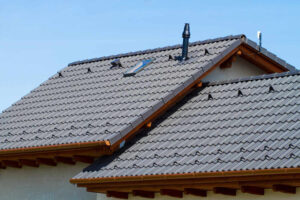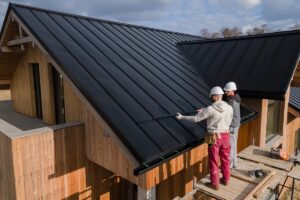How Weather Affects Your Roofing: Preparing for Storm Season
Roofing plays a vital role in protecting your home from the elements. However, extreme weather conditions can take a toll on even the most durable roofing materials. Understanding how weather impacts your roof and taking proactive steps to prepare for storm season is essential for maintaining the longevity and safety of your home.
The Impact of Heavy Rain on Roofing
 Heavy rain can be particularly damaging to roofing systems, especially if there are pre-existing issues. Water can seep into small cracks or weak points, leading to leaks that compromise the integrity of your home. Over time, continuous exposure to heavy rain can cause mold growth, rot, and structural damage. Ensuring proper drainage with clean gutters and downspouts is crucial to minimizing water-related issues.
Heavy rain can be particularly damaging to roofing systems, especially if there are pre-existing issues. Water can seep into small cracks or weak points, leading to leaks that compromise the integrity of your home. Over time, continuous exposure to heavy rain can cause mold growth, rot, and structural damage. Ensuring proper drainage with clean gutters and downspouts is crucial to minimizing water-related issues.
High Winds and Roof Vulnerability
Strong winds can cause shingles to loosen, curl, or even blow away entirely. Missing shingles expose the underlying roof deck to the elements, increasing the risk of leaks and further damage. Additionally, wind can lift the edges of the roof, creating vulnerabilities that allow debris and moisture to penetrate. Regular inspections and repairs are key to keeping your roof secure during high winds.
Hailstorms and Their Destructive Effects
Hail can be particularly harsh on roofing materials, leaving dents, cracks, and punctures. The severity of the damage often depends on the size and speed of the hailstones. Asphalt shingles and metal roofs may experience surface damage, while tiles can crack or shatter. After a hailstorm, a professional inspection can identify and address any potential problems before they worsen.
Snow and Ice: A Winter Concern
In colder climates, snow and ice can create unique challenges for roofing. The weight of accumulated snow may stress the structure, while melting snow can refreeze at the edges, forming ice dams. Ice dams prevent proper drainage, leading to water backup that can leak into your home. Adequate insulation and ventilation are essential to preventing these winter-related roofing issues.
Intense Heat and UV Radiation
 While storms are a common concern, intense heat and prolonged UV exposure can also damage roofing materials. Over time, shingles may dry out, crack, or fade due to constant sun exposure. Heat can also warp metal roofing or cause tar-based materials to soften. Selecting weather-resistant roofing materials and performing regular maintenance can help mitigate heat-related damage.
While storms are a common concern, intense heat and prolonged UV exposure can also damage roofing materials. Over time, shingles may dry out, crack, or fade due to constant sun exposure. Heat can also warp metal roofing or cause tar-based materials to soften. Selecting weather-resistant roofing materials and performing regular maintenance can help mitigate heat-related damage.
Preparing Your Roof for Storm Season
Preparation is the best defense against weather-related roofing problems. Start by scheduling a professional roof inspection to identify and address any vulnerabilities. Repairing damaged shingles, securing flashing, and clearing debris from gutters are all essential steps to safeguard your roof. Additionally, trimming overhanging branches reduces the risk of falling debris during storms.
Investing in high-quality, weather-resistant materials can also provide added peace of mind. Modern roofing technologies offer enhanced durability, making your roof more resilient to extreme conditions.

 When working with a small outdoor area, every inch counts. Selecting a deck design that complements your home’s architectural style and optimizes the available space is crucial. Opt for layouts that include built-in seating, planters, or multi-functional elements. Raised decks can create additional storage space beneath, while ground-level designs blend seamlessly with your yard.
When working with a small outdoor area, every inch counts. Selecting a deck design that complements your home’s architectural style and optimizes the available space is crucial. Opt for layouts that include built-in seating, planters, or multi-functional elements. Raised decks can create additional storage space beneath, while ground-level designs blend seamlessly with your yard. Eco-conscious homeowners can explore sustainable roofing options that align with their values. Green roofs, which feature layers of vegetation, are a striking choice that offers insulation and environmental benefits. While these may require more maintenance, they are an excellent fit for homeowners looking to reduce their carbon footprint.
Eco-conscious homeowners can explore sustainable roofing options that align with their values. Green roofs, which feature layers of vegetation, are a striking choice that offers insulation and environmental benefits. While these may require more maintenance, they are an excellent fit for homeowners looking to reduce their carbon footprint.